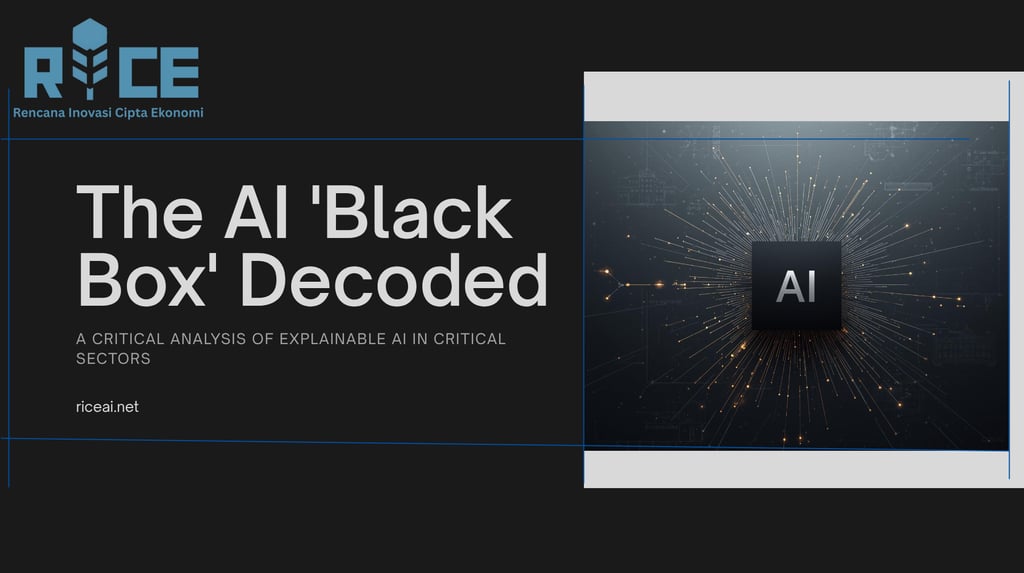The AI 'Black Box' Decoded: A Critical Analysis of Explainable AI (XAI) in High-Stakes Fields
This analysis explores Explainable AI (XAI) in high-stakes fields, addressing trust, ethics, and regulatory demands for transparent, accountable AI systems.
AI INSIGHT
Rice AI (Ratna)
10/20/20259 min read


Imagine a scenario where an artificial intelligence system makes a life-altering decision – perhaps denying a crucial medical treatment, flagging a financial transaction as fraudulent, or even influencing a judicial ruling. Now, imagine that decision comes with no clear rationale, no discernible path from input to output. This is the ominous "AI black box" phenomenon, a growing concern as AI permeates our most critical sectors. The inability to understand why an AI made a specific prediction or decision poses significant challenges to trust, accountability, and ethical deployment.
In high-stakes fields, transparency in AI is no longer a luxury; it is a fundamental necessity. This pressing need gives rise to Explainable AI (XAI), a paradigm shift focused on developing AI models that are not only effective but also comprehensible to humans. XAI seeks to demystify complex algorithms, offering insights into their reasoning processes. For industry experts and professionals, understanding XAI is paramount for navigating the evolving landscape of AI governance and responsible innovation. We at Rice AI believe that true intelligence lies in understanding, not just predicting.
Why XAI Isn't Optional: Trust, Ethics, and Regulatory Demands
The deployment of AI in critical domains demands more than just accuracy; it requires a bedrock of trust. When AI systems influence fundamental aspects of human life, their decisions must be auditable, fair, and transparent. Without explainability, challenging an erroneous AI decision becomes nearly impossible, eroding public confidence and inviting significant ethical and legal ramifications.
Critical Applications: Healthcare, Finance, Justice
Consider healthcare, where AI assists in diagnosing diseases, personalizing treatments, and even guiding surgical procedures. A diagnostic AI recommending a specific therapy must be able to explain why it reached that conclusion, detailing the specific patient data points that influenced its output. This transparency allows medical professionals to validate the recommendation and ensures patient safety.
In the financial sector, AI models assess creditworthiness, detect fraud, and manage investment portfolios. If an AI denies a loan application or flags a legitimate transaction, the affected individual has a right to understand the underlying rationale. Explainable AI can illuminate which financial factors or behavioral patterns led to the decision, helping to identify and mitigate potential biases in lending practices. Similarly, in the justice system, AI tools are used for risk assessment in sentencing or parole decisions. Here, the ethical imperative for transparent and fair algorithms is perhaps at its highest, demanding clear explanations to ensure due process and prevent algorithmic discrimination.
Legal and Ethical Frameworks
The global regulatory landscape is increasingly reflecting the demand for AI explainability. Regulations like the European Union’s General Data Protection Regulation (GDPR) implicitly introduce a "right to explanation" for individuals affected by automated decisions. Emerging AI ethics guidelines from various international bodies explicitly call for transparency, interpretability, and auditability in AI systems. These frameworks underscore that organizations deploying AI must be able to explain their algorithms’ behavior, especially when decisions impact individuals significantly. Failure to comply can result in substantial penalties and irreparable damage to reputation. This regulatory pressure makes XAI not just a technical challenge but a strategic business imperative.
Unveiling the Mechanisms: Approaches to XAI
The challenge of explainable AI is complex, as different stakeholders require different types of explanations. A data scientist might need detailed model weights, while a clinician might require a simple, actionable reason for a diagnosis. XAI techniques are broadly categorized to address this spectrum of needs, aiming to bridge the gap between AI's analytical power and human comprehension.
Model-Specific vs. Model-Agnostic Methods
XAI techniques can be broadly divided into two categories based on their relationship with the model architecture. Model-specific methods are tailored to particular types of models, often leveraging their inherent structures for explanations. For instance, decision trees are inherently interpretable; their rules directly explain outcomes. However, complex deep learning models lack this intrinsic transparency.
Model-agnostic methods, conversely, can be applied to any trained AI model, regardless of its internal complexity. Techniques like LIME (Local Interpretable Model-agnostic Explanations) and SHAP (SHapley Additive exPlanations) fall into this category. These methods probe the model by systematically changing inputs and observing output variations, effectively reverse-engineering the decision process. They are incredibly valuable when working with proprietary or highly complex black-box models, providing a flexible way to gain insights.
Local vs. Global Explanations
Another critical distinction in XAI is between local and global explanations. Local explanations focus on justifying a single prediction made by the model. For example, why did the AI classify this specific image as a cat? LIME and SHAP are excellent for providing local explanations, highlighting the features most influential for that particular output. This is crucial in high-stakes situations where individual decisions need rigorous justification.
Global explanations, on the other hand, aim to provide an overall understanding of the model's behavior. How does the AI generally differentiate between cats and dogs? This might involve understanding which features are generally most important across all predictions, or visualizing the decision boundaries of the model. Global explanations help developers debug models, identify biases, and ensure the model aligns with domain expertise. Both local and global explanations are vital for a holistic understanding of AI systems.
Visual and Textual Explanations
The format in which explanations are presented is just as important as the explanation itself. Visual explanations leverage graphical representations to convey insights intuitively. Saliency maps, for instance, highlight specific regions in an image that an AI model focused on when making a classification. Feature importance plots show which input variables contributed most to a model's prediction, often presented as bar charts. These visual aids are powerful for non-technical stakeholders to grasp complex relationships quickly.
Textual explanations provide human-readable narratives or rule sets. For example, an AI might explain a loan denial by stating: "Your credit score (620) is below the threshold (650) for this loan product, and your debt-to-income ratio (45%) exceeds the acceptable limit (40%)." These explanations are critical for compliance, audit trails, and for empowering users to understand and act upon AI recommendations. The best XAI systems often combine both visual and textual elements for comprehensive clarity.
The Road Ahead: Navigating XAI Complexities
While the promise of XAI is immense, its implementation is far from straightforward. Developers and organizations face a series of inherent challenges that necessitate careful consideration and strategic planning. Overcoming these complexities is key to unlocking the full potential of responsible AI deployment.
The Trade-off Between Interpretability and Performance
One of the most widely discussed dilemmas in XAI is the perceived trade-off between a model's interpretability and its predictive performance. Simpler models, like linear regressions or decision trees, are often highly interpretable but may sacrifice accuracy when dealing with highly complex, non-linear data. Conversely, powerful deep learning models, known for their superior performance in tasks like image recognition or natural language processing, are typically opaque.
Achieving high levels of both accuracy and transparency often requires innovative architectural choices or the application of sophisticated post-hoc XAI techniques. The goal is not always to fully "open" the black box, but rather to extract sufficient, reliable explanations without unduly compromising the model's effectiveness. Navigating this balance is a continuous research and development effort, ensuring AI solutions remain both powerful and accountable.
The Challenge of Human Interpretation
An explanation is only useful if a human can understand and correctly interpret it. This presents a significant challenge: explanations must be tailored to the target audience, whether they are domain experts, regulators, or end-users. Technical jargon or overly complex visualisations can render even accurate explanations ineffective. Furthermore, human cognitive biases can influence how explanations are perceived, potentially leading to misinterpretations or over-reliance on explanations, even when they are flawed.
Designing XAI tools requires a deep understanding of human factors and user experience principles. The goal is to provide actionable insights that foster appropriate trust and enable informed decision-making, rather than simply presenting a list of influential features. This user-centric approach ensures that explanations genuinely empower users to engage critically with AI outputs.
Ensuring Robustness and Trustworthiness of Explanations
The reliability of XAI explanations is paramount. Just as an AI model can be susceptible to adversarial attacks, so too can its explanations. Malicious actors could potentially manipulate models to generate misleading explanations, masking discriminatory behavior or vulnerabilities. Therefore, it is critical to ensure that XAI methods themselves are robust and that their outputs are trustworthy.
Techniques for validating explanations, such as consistency checks, sensitivity analysis, and comparison with domain expertise, are essential. Without confidence in the explanations, the entire purpose of XAI—building trust and accountability—is undermined. This area is a crucial frontier in AI safety research, ensuring that our attempts to illuminate AI behavior do not inadvertently create new vulnerabilities.
Scaling XAI Solutions
Implementing XAI across large-scale, enterprise-level AI systems presents considerable practical challenges. Organizations often deploy hundreds or thousands of AI models, each with varying architectures and purposes. Developing and integrating XAI for each of these models, maintaining consistency, and ensuring that explanations are generated efficiently and at scale, is a monumental task. This includes managing computational overhead and data requirements for explanation generation.
This is where expertise in AI operations (MLOps) and scalable XAI frameworks becomes critical. At Rice AI, we specialize in developing scalable, trustworthy AI solutions that incorporate XAI from the ground up. Our approach ensures that explainability is not an afterthought, but an integral part of the AI development lifecycle, designed for seamless integration into complex enterprise environments. We provide the tools and methodologies to manage, monitor, and explain AI models comprehensively, regardless of scale.
Beyond the Hype: Practical Steps and Future Directions for XAI
The journey towards truly explainable AI is ongoing, but significant progress is being made. Organizations must move beyond theoretical discussions to integrate XAI into their practical AI strategies. This involves adopting new methodologies, leveraging advanced tools, and recognizing XAI as a core component of responsible innovation.
Integrating XAI into the AI Development Lifecycle
The most effective approach to XAI is to adopt an "explainability by design" philosophy. This means considering interpretability requirements from the very initial stages of AI model development, rather than attempting to add explanations as a post-hoc patch. This might involve selecting inherently interpretable models where appropriate, or designing more complex models with built-in hooks for explanation generation.
Integrating XAI seamlessly into the MLOps pipeline is also crucial. This ensures that explanations are generated, stored, and monitored alongside model predictions. Tools and frameworks are emerging that support this integration, enabling developers to build, deploy, and manage explainable AI systems more efficiently. This holistic approach ensures that AI systems are auditable, transparent, and debuggable throughout their entire lifecycle.
XAI as a Competitive Advantage
Far from being merely a compliance burden, XAI is rapidly becoming a strategic differentiator and a source of competitive advantage. Companies that can clearly explain their AI's decisions foster greater trust with customers, partners, and regulators. This transparency can accelerate the adoption of AI solutions, reduce legal and reputational risks, and even uncover new business insights that were previously hidden within opaque models.
For example, understanding why an AI model recommends a particular product can help businesses refine their marketing strategies, improve product design, and better understand customer behavior. At Rice AI, we believe XAI isn't just a compliance burden; it's a strategic asset. Our solutions empower businesses to not only understand their AI but to leverage that understanding for innovation and growth, ensuring clear insights even in the most complex AI applications. We help our clients transform transparency into tangible business value.
Emerging Trends in XAI Research
The field of XAI is dynamic, with continuous advancements pushing the boundaries of what's possible. Researchers are exploring novel techniques such such as causal inference, which aims to explain predictions based on cause-and-effect relationships rather than mere correlations. Counterfactual explanations provide "what if" scenarios, detailing the minimum changes to input features that would alter a model's prediction—e.g., "If your credit score were 660 instead of 620, your loan would have been approved."
Another exciting area is multimodal XAI, which seeks to provide explanations for AI systems that process multiple data types, like combining text, images, and audio. These advanced techniques promise to deliver even richer, more human-centric explanations, further bridging the gap between sophisticated AI and human understanding. Staying abreast of these trends is essential for anyone serious about the future of responsible AI.
Conclusion
The era of the unquestioned AI 'black box' is drawing to a close, especially in high-stakes fields where algorithmic decisions carry significant weight. Explainable AI (XAI) is not merely a technical add-on; it is a foundational requirement for building trustworthy, ethical, and accountable AI systems. From healthcare diagnostics to financial decisions and judicial processes, the imperative to understand why an AI acts as it does is non-negotiable. The challenges are real—balancing performance with interpretability, designing user-friendly explanations, and ensuring the robustness of XAI methods—but the solutions are rapidly evolving.
As AI continues its pervasive integration into our lives, the ability to decode its decisions will define the success and societal acceptance of this transformative technology. Organizations must embrace an "explainability by design" philosophy, integrating XAI throughout their AI development and deployment lifecycles. This proactive approach not only mitigates risks associated with opaque AI but also unlocks competitive advantages, fostering deeper trust and enabling more informed strategic decisions. The future of AI is transparent, and those who champion explainability will lead the way.
At Rice AI, we are at the forefront of this evolution, dedicated to crafting AI solutions that are not only powerful but also transparent, ethical, and easily understood. We partner with industry experts and professionals to demystify complex AI, ensuring that your organization can deploy AI with confidence, accountability, and a clear understanding of its intelligence. Don't let the AI black box limit your potential or expose you to unnecessary risk.
Ready to unlock the full potential of your AI with transparency and trust? Visit Rice AI today to explore our XAI solutions and learn how we can help you integrate explainability into your critical AI applications.
#ExplainableAI #XAI #AITransparency #EthicalAI #ResponsibleAI #AIGovernance #BlackBoxAI #MachineLearning #AIEthics #HighStakesAI #AIinHealthcare #AIinFinance #AIDecisions #Interpretability #AIStrategy #DailyAIIndustry
RICE AI Consultant
To be the most trusted partner in digital transformation and AI innovation, helping organizations grow sustainably and create a better future.
Connect with us
Email: consultant@riceai.net
+62 822-2154-2090 (Marketing)
© 2025. All rights reserved.


+62 851-1748-1134 (Office)
IG: @riceai.consultant
